 Digital camera heavyweights Sony have rolled out their first wireless Cyber-Shot digital camera, the 6-megapixel Cyber-shot DSC-G1.
Digital camera heavyweights Sony have rolled out their first wireless Cyber-Shot digital camera, the 6-megapixel Cyber-shot DSC-G1.
The G1 is Sony’s first wireless digicam able to send photos to other Digital Living Network Alliance (DLNA)-enabled devices (like other cameras and PCs) and Phil Lubell, director of marketing for digital cameras at Sony Electronics was ready to big up the technology: “This is a step towards realizing a platform for networked photo communication.”
“We will continue to explore the possibilities for networked digital imaging as broadband Internet becomes more pervasive in American homes,” he added.
The groundbreaking camera comes with a positively ginormous, 3.5-inch, 921k pixel screen, a whopping 2GB of internal storage, optical stabilisation and wireless connectivity.
 The metal bodied Cyber-shot model sports an eye catching design, with a Carl Zeiss 3x optical zoom lens (38-114mm, 35mm equiv) lurking behind a horizontally sliding cover.
The metal bodied Cyber-shot model sports an eye catching design, with a Carl Zeiss 3x optical zoom lens (38-114mm, 35mm equiv) lurking behind a horizontally sliding cover.
Socialites keen to grab that decisive party moment will like Sony’s claim that the camera can be ready to shoot in less than a second, with the built in Super Steady Shot optical image stabilisation keeping the cocktail shakes at bay.
In line with its party animal aspirations, the G1 has high light sensitivity – up to ISO 1000 – for grabbing natural, low light shots.
Hefty Storage
When it comes to internal storage, Sony have been very generous and strapped in a mighty 2GB of internal memory, good enough to store a holiday’s worth of pics (that’s 7,500 VGA-quality photos or 600 6-megapixel pictures).
 There’s also a memory slot onboard for storing yet more photos, but Sony are sticking with their less widespread Memory Stick Duo/Memory Stick PRO Duo format, which can now store up to eight gigabytes.
There’s also a memory slot onboard for storing yet more photos, but Sony are sticking with their less widespread Memory Stick Duo/Memory Stick PRO Duo format, which can now store up to eight gigabytes.
Sony have also added an “auto image management system” which lets snappers organize their photos by events, keywords and labels and – remarkably – lets user select someone’s face and search for other photos with the same face, same colour, or a similar composition.
The DSC-G1 digital camera will be slipping on to the shelves in April, priced at around $600.
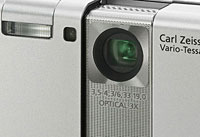
Sony DSC-G1 specifications
Sensor 1/2.5″ Type CCD, 6.0 million effective pixels
Image sizes 2816 x 2112, 2048 x 1536, 1632 x 1224, 640 x 480, 2816 x 1872 (3:2), 1920 x 1080 (16:9)
Movie clips 640 x 480 @30fps, 320 x 240 @ 30fps
File formats JPEG, DPOF, MS Video LV4
Lens Carl Zeiss Vario-Tessar, 3x optical zoom, 38-114mm (35mm equiv), F3.5-4.3
Image stabilisation SuperSteadyShot
Focus AF area modes 9-point
AF assist lamp Yes
Focus distance AF: 50cm
Macro: 8cm (wide) 25cm (tele)
Metering Multi-pattern, Center-weighted, Spot
ISO sensitivity ISO 80 – ISO 1000
Exposure compensation +/-2EV in 1/3EV increments
Exposure bracketing 3 frames @ +/-0.3 / 0.7 / 1.0EV
Shutter speed Auto: 1/4-1/1000, P: 1-inch-1/1000
Slow shutter: 1/6sec or slower
Aperture F3.5-5.6 (wide) F4.3-7.1 (tele)
Modes Auto, Program Auto, Scene
Scene modes Twilight, Twilight Portrait, Landscape, Beach, Snow, Fireworks, High Speed, Shutter, High Sensitivity, Soft Snap, Handheld Twilight
White balance Image Sensor – Auto, Daylight, Cloudy, Fluorescent, Incandescent, Flash
Self timer 2 or 10 sec
Continuous shooting max 7 shots @ 3.3fps
Flash Auto, On, Slow Synch, Off, Red-eye reduction, Auto Daylight Synch
Range: 0.1-2.8m (wide) 0.25-2.2m (tele)
Viewfinder No
LCD monitor 3.5-inch, 921,000 pixels
Connectivity Cradle, USB 2.0, AV out, DC in, WiFi (b/g)
Storage Memory Stick / Pro Duo, 1.86GB internal memory
Power Rechargeable Lithium-ion battery NP-FR1
Weight (no batt) 204 g (7.2 oz)
Dimensions 93.3 x 71.7 x 25.3 mm (3 11/16 x 2 13/16 x 1 in)
Sony
 In the interview with German weekly magazine Focus, published today, she poses the following question, “”Do you think it’s fine that a CD plays in all CD players but that an iTunes song only plays in an iPod?” It’s followed by a couple of words that are going to make uncomfortable reading for Apple, “I don’t. Something has to change.”
In the interview with German weekly magazine Focus, published today, she poses the following question, “”Do you think it’s fine that a CD plays in all CD players but that an iTunes song only plays in an iPod?” It’s followed by a couple of words that are going to make uncomfortable reading for Apple, “I don’t. Something has to change.” Three Quarters Of Consumers Naffed Off With Mobile Web
Three Quarters Of Consumers Naffed Off With Mobile Web Mercer joined Apple in 1987 and was the lead designer of Version 7 of the Macintosh finder before founding a software tools firm called Pixo which was involved in designing the first version of the iPod user interface.
Mercer joined Apple in 1987 and was the lead designer of Version 7 of the Macintosh finder before founding a software tools firm called Pixo which was involved in designing the first version of the iPod user interface. Voice-recognition software, Apple’s most advanced to date, can recite a speech highlighting the features of the device while injecting several clever digs at competitors.
Voice-recognition software, Apple’s most advanced to date, can recite a speech highlighting the features of the device while injecting several clever digs at competitors.  After growing tired of endless beer-fuelled, late night rummages around the house for a mountain of easily-lost remote controls, we thought we’d check out an all-in-one controller.
After growing tired of endless beer-fuelled, late night rummages around the house for a mountain of easily-lost remote controls, we thought we’d check out an all-in-one controller. 

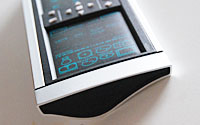 The Kameleon only managed to find one set of codes that immediately worked on our devices; there was nothing for our 3 year old AV Yamaha amp and it neither had codes for our new Humax PVR nor wanted to learn any either (the learning process involved us continually bashing a single button, but the remote kept quitting before it found anything for the PVR).
The Kameleon only managed to find one set of codes that immediately worked on our devices; there was nothing for our 3 year old AV Yamaha amp and it neither had codes for our new Humax PVR nor wanted to learn any either (the learning process involved us continually bashing a single button, but the remote kept quitting before it found anything for the PVR). By this time we were beginning to harbour thoughts about how far we could throw the streamlined remote, but thought we’d drop One For All a line for help instead.
By this time we were beginning to harbour thoughts about how far we could throw the streamlined remote, but thought we’d drop One For All a line for help instead.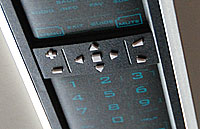 Moreover, we were reminded of the shortcomings of ‘virtual’ buttons versus real hardware buttons – groovy glowing buttons emerging from the darkness of a black remote may look the stuff of Spock, but ‘real’ buttons remain easier to use and more responsive to the touch (something that those dreaming of an iPhone might want to consider).
Moreover, we were reminded of the shortcomings of ‘virtual’ buttons versus real hardware buttons – groovy glowing buttons emerging from the darkness of a black remote may look the stuff of Spock, but ‘real’ buttons remain easier to use and more responsive to the touch (something that those dreaming of an iPhone might want to consider). This just feels wrong on just about every level we can think of, but in an attempt to reach out to Da Yoot, the US Army have created a slick and highly polished MySpace recruitment site.
This just feels wrong on just about every level we can think of, but in an attempt to reach out to Da Yoot, the US Army have created a slick and highly polished MySpace recruitment site. A warning next to the psychopathic-looking Sgt Star warns, “The information you enter is to be used only for recruiting Soldiers into the U.S. Army and the Army Reserve.”
A warning next to the psychopathic-looking Sgt Star warns, “The information you enter is to be used only for recruiting Soldiers into the U.S. Army and the Army Reserve.” We apologised: “OK. Sorry. We want to go to Iraq and bomb some soft Johnny Foreigners back into the Stone Age in the name of peace.”
We apologised: “OK. Sorry. We want to go to Iraq and bomb some soft Johnny Foreigners back into the Stone Age in the name of peace.”  Clearly a sizeable wad of defence budget has been thrown at the slick game, which purports to offer realistic battlefield scenes (although we couldn’t find any options to rain friendly fire on Brit troops and then try and cover up the investigation afterwards.)
Clearly a sizeable wad of defence budget has been thrown at the slick game, which purports to offer realistic battlefield scenes (although we couldn’t find any options to rain friendly fire on Brit troops and then try and cover up the investigation afterwards.)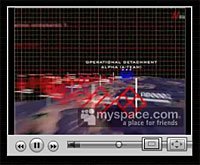 Of course, there’s sound business reasoning behind the US Army shoving its shiny size nines onto a social networking site like MySpace, with the site able to interact with the community, make friends and receive comments and – possibly – make the Army look vaguely cool and enticing.
Of course, there’s sound business reasoning behind the US Army shoving its shiny size nines onto a social networking site like MySpace, with the site able to interact with the community, make friends and receive comments and – possibly – make the Army look vaguely cool and enticing. Digital camera heavyweights Sony have rolled out their first wireless Cyber-Shot digital camera, the 6-megapixel Cyber-shot DSC-G1.
Digital camera heavyweights Sony have rolled out their first wireless Cyber-Shot digital camera, the 6-megapixel Cyber-shot DSC-G1. There’s also a memory slot onboard for storing yet more photos, but Sony are sticking with their less widespread Memory Stick Duo/Memory Stick PRO Duo format, which can now store up to eight gigabytes.
There’s also a memory slot onboard for storing yet more photos, but Sony are sticking with their less widespread Memory Stick Duo/Memory Stick PRO Duo format, which can now store up to eight gigabytes.
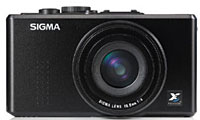 Sigma have announced the full details of their new DP1 camera, a high end point’n’shoot digital camera packing a hefty 14 megapixels resolution with a full size image sensor.
Sigma have announced the full details of their new DP1 camera, a high end point’n’shoot digital camera packing a hefty 14 megapixels resolution with a full size image sensor.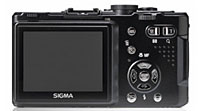 Camera controls
Camera controls The 28mm fixed lens is disappointingly slow at just f4, but this may be compensated by improved high ISO performance.
The 28mm fixed lens is disappointingly slow at just f4, but this may be compensated by improved high ISO performance. Specifications
Specifications
 A few months ago Palm shelled out $44 million to Japan’s Access Systems for a perpetual license of the operating system used by Treo smartphones and PDAs, ensuring that current and future Palm handhelds remain compatible with Palm’s Garnet OS.
A few months ago Palm shelled out $44 million to Japan’s Access Systems for a perpetual license of the operating system used by Treo smartphones and PDAs, ensuring that current and future Palm handhelds remain compatible with Palm’s Garnet OS. Treo 755p
Treo 755p A pretty staggering number, even when you realise that it includes all of the downloads and possibly all upgrades of the software (* We’re in the process of checking this with Skype HQ).
A pretty staggering number, even when you realise that it includes all of the downloads and possibly all upgrades of the software (* We’re in the process of checking this with Skype HQ). Gordon Brown has announced that a new labelling system for media content is in the works, designed to help parents protect their children from dodgy digital content.
Gordon Brown has announced that a new labelling system for media content is in the works, designed to help parents protect their children from dodgy digital content. As part of the scheme, Ofcom will introduce common labelling standards covering cinema, TV, radio, computer games and the internet.
As part of the scheme, Ofcom will introduce common labelling standards covering cinema, TV, radio, computer games and the internet. When an important deal like
When an important deal like